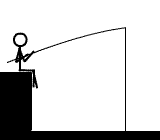Post by daveedka on Feb 15, 2010 17:36:58 GMT -5
O.k. in part two I want to talk about the way we rig the rods and what basic tackle we use. We mentioned Bobbers, but it should be noted that I have become very specific about what type of bobber and how it is rigged. Years ago when I first started drifting flats we simply used the bobbers we already had for panfishing etc. These were usually of the type that attached by sliding back a spring and wrapping the line around the bobber shaft then letting the spring return to hold the line. we also used a few other versions of clip on bobbers. we quickly found that with big fish we often broke line and it always broke right at the point where the bobber attached. so we quit using anything that kinked, stretched, or otherwise might weaken the line. Slip bobbers were the answer and we even found that anything but string type bobber stops would compromise line strength. Bear in mind this effect didn't make a difference with little fish, only with the monsters that really upset you when you lose them.
Here are some pictures of the basic tackle we use, I did not picture the BWAB or the Fishkabobber, but both can be used when working with smaller baits, and calm conditions. for larger baits or windy conditins, big bobbers and heavier weights are a must. With windy conditions, drift speeds increase so it takes some weight to keep the bait pulled down, with large live baits, we usually use a lot of weight just to ensure that the bait doesn't swim up out of feeding range.
To rig a rod I attach a bobber stop, a bead or two, then a large bobber, a couple more beads and then a large Snap swivel. Do not get cheap on the swivels, you don't want that little piece of wire giving up on your trophy cat. I use nothing smaller than a #3/0 swivel as I've had more than a couple of smaller swivels fail on me.
Here are the typical bobbers we use, anything that will hold a large bait and 3/4 oz of weight will work well, I prefer the Comal styrofoam floats because it's easy to attach light sticks to the stems.

Here are our standard Sinker, bobber stop and swivel choices. The sinker size is of course variable based on bait, conditions, and bobber size but with the 2 1/4" comal pear float, 3/4 oz of lead is about perfect.

Here is a picture of how I rig the rods, I use Palomar Knots almost exclusively because they are easy to tie and extremely strong.

In part 3 I will talk about hook rigs, knots, and storage of rigged rods and hook rigs. I'll also talk about vartiations I use on this basic set-up when conditions make drifting less than desireable.
dave
Here are some pictures of the basic tackle we use, I did not picture the BWAB or the Fishkabobber, but both can be used when working with smaller baits, and calm conditions. for larger baits or windy conditins, big bobbers and heavier weights are a must. With windy conditions, drift speeds increase so it takes some weight to keep the bait pulled down, with large live baits, we usually use a lot of weight just to ensure that the bait doesn't swim up out of feeding range.
To rig a rod I attach a bobber stop, a bead or two, then a large bobber, a couple more beads and then a large Snap swivel. Do not get cheap on the swivels, you don't want that little piece of wire giving up on your trophy cat. I use nothing smaller than a #3/0 swivel as I've had more than a couple of smaller swivels fail on me.
Here are the typical bobbers we use, anything that will hold a large bait and 3/4 oz of weight will work well, I prefer the Comal styrofoam floats because it's easy to attach light sticks to the stems.

Here are our standard Sinker, bobber stop and swivel choices. The sinker size is of course variable based on bait, conditions, and bobber size but with the 2 1/4" comal pear float, 3/4 oz of lead is about perfect.

Here is a picture of how I rig the rods, I use Palomar Knots almost exclusively because they are easy to tie and extremely strong.

In part 3 I will talk about hook rigs, knots, and storage of rigged rods and hook rigs. I'll also talk about vartiations I use on this basic set-up when conditions make drifting less than desireable.
dave








